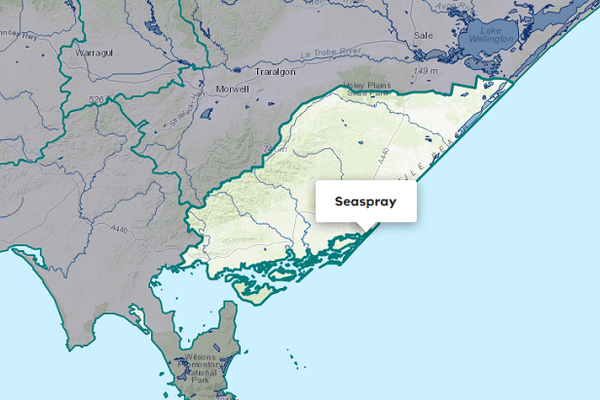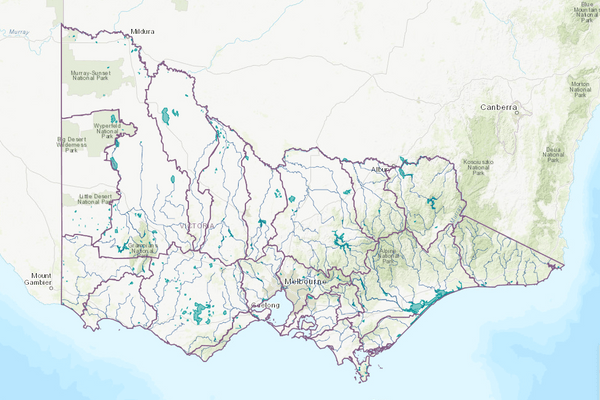About the area
The Central Gippsland groundwater catchment is in Victorias east, and it contains the Gippsland Lakes.
The Central Gippsland groundwater catchment contains the Rosedale groundwater management area (GMA), Wa De Lock GMA, Denison GMA, Sale water supply protection area (WSPA), Stratford GMA, Moe GMA, Yarram WSPA, and Wy Yung GMA. The area not covered by these is reported as outside management units.
The Stratford GMA and Yarram WSPA extend into the Seaspray groundwater catchment. The Moe GMA straddles this catchment and the Moe groundwater catchment.
Groundwater resources within the catchment supply licensed entitlements, domestic and stock use, urban use to Sale, Boisdale, Briagolong, and Lindenow, and power generation in the Latrobe Valley.
More information on water management and accounting is detailed in Water explained.
2022-23 overview
Urban supply
Groundwater supplied to 2 towns in the catchment.
Water use
More water was used for consumptive purposes than the previous year.
Climate
Rainfall
Less rainfall was received in the Central Gippsland groundwater catchment in 2022-23 than the previous year, being close to the long-term average in some areas. Rainfall was:
- was the highest recorded in the reference period (1975 to 2023) in an area east of Lake Eildon
- very much above average over the north-west Alpine regions of the catchment
- above average in the south-west, in a band running along the edge of the Alpine regions, and in the north-east of the catchment
- average along the coast and in central regions from Rosedale to Ensay.
Figure 1 displays the rainfall received in 2022-23 compared to the long-term average (1975-2023).
Figure 1: Rainfall deciles, Central Gippsland groundwater catchment
Sourced from the Australian Bureau of Meteorology
Groundwater level trends
In the Accounts, groundwater level trends for groundwater management units (GMUs) have been determined by monitoring data from key bores in the State Observation Bore Network. Trend determinations are made quarterly by comparing each reading to a previous reading in the same season 5 years prior; for example, a summer record is compared to the summer record from 5 years earlier to account for seasonality.
Groundwater resources are being actively managed. For more detail on management responses, go to on the Southern Rural Water website.
In 2022-23, groundwater level trends for the Moe and Rosedale GMA were declining towards the end of the year. Trends for the Stratford, Wa De Lock and Wy Yung GMAs, and the Sale WSPA were declining towards the end of the year. The trend for the Yarram WSPA was stable towards the end of the year.
There are insufficient state observation bores in the Denison GMA to adequately define the groundwater resource or changes to the resource over time.
Table 1: Groundwater level trends, Central Gippsland groundwater catchment
Entitlements and use
Groundwater licence and use volumes in the Central Gippsland groundwater catchment are shown below. Domestic and stock use does not require a licence, so in the Groundwater availability and use table, these rows only report water taken.
The licensed volume used under entitlements must not exceed the volume made available to individual licensed entitlement holders. We report on compliance in the GMU local reports and in Statewide groundwater.
Water used
Use in the Central Gippsland groundwater catchment was 52,622 ML, more than the 41,216 ML used in the previous year.
Entitlement volumes
Rights to water in the Central Gippsland groundwater catchment are shown below.
Table 2: Groundwater entitlements at 30 June, Central Gippsland groundwater catchment
Available water and use
The table below shows the total water available and used under entitlements, and estimated domestic and stock use in 2022-23. Total water available under entitlements is the sum of opening carryover, allocation issued and the net trade in or out of water.
Estimated domestic and stock use is calculated based on an assumed usage per registered bore per year. In this catchment, the assumed usage is 1.5 ML usage per bore per year.
More information on groundwater use and availability has been detailed in How we account for .
In 2022-23, 52,622 ML of water was extracted for consumptive purposes, which was more than the 41,216 ML extracted in the previous year. Of this volume, 23,741 ML was for power generation use, 25,059 ML was for non-urban (irrigation) use, 1,934 ML was for urban use and 1,888 ML was estimated to be for domestic and stock use.
There were no restrictions on use in the Central Gippsland groundwater catchment in 2022-23.
Table 3: Groundwater availability and use, Central Gippsland groundwater catchment
Management responsibilities
Management of water in the Central Gippsland groundwater catchment is undertaken by Southern Rural Water.
| Authority | Management responsibilities |
|---|---|
| Southern Rural Water |
|






